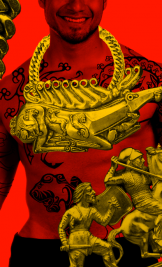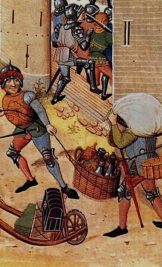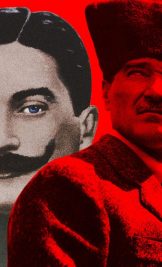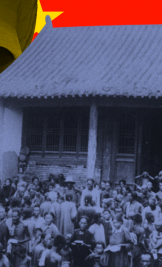

5 rulers of the past who died especially stupidly
Choked to death, laughed too hard, or could not stand his own wedding night. The deaths of all-powerful monarchs were far from as pompous as their lives.
453 CE
Attila: choked on blood in his sleep
In the 4th century, the invasion of the nomadic Hun tribe provoked the Migration Period, when peoples moved from the east to the west of Europe. The weak fled from the strong. By the beginning of the 5th century, a fragile stability was established: the Huns settled in the area of modern Hungary and were recruited into the Roman army. In 434, Attila became their ruler. Over the next twenty years, he managed to fight both the Eastern and Western Roman Empires, to rule the lands from the Volga to the Rhine, and to extend his power to fifty Turkic, Iranian-speaking, Germanic, and Slavic tribes.
Attila’s foes called him ‘wicked and cunning,’ ‘lover of war,’ ‘destroyer of Europe,’ and ‘Scourge of God.’ Attila himself is credited with saying: ‘There, where I have passed, grass will never grow again.’ He was the king of Scythia, the ruler of the Germans, but he dreamed of capturing Constantinople and Rome. In that he did not succeed.
The exact number of Attila’s wives and concubines is unknown. Legend has it that a new girl was brought to him every night. According to the Byzantine diplomat Priscus, Attila died after a banquet during another wedding. He overdosed on food and alcohol and was found in a pool of his own blood in the morning. Probably, he had a nosebleed at night. The drunken monarch did not wake up and choked to death.
The 6th-century historian Jordanes described Attila’s burial: ‘At night, secretly, the corpse is buried, firmly placed in [three] coffins: the first of gold, the second of silver, and the third of strong iron. In order to prevent people’s curiosity in the face of such great wealth, they killed all those entrusted with this task.’ The king’s tomb has not been found to this day.
What happened next: the territory of the Hun state began to shrink, and Attila’s sons with the main forces of the tribe retreated to the mouth of the Danube, then to the Azov and Caspian Seas.

1190 CE
Frederick I Barbarossa: drowned in public
The King of Germany and the ruler of the Holy Roman Empire considered himself the heir to the Caesars and was remarkable for his belligerence and desire to expand his lands. He took part in two crusades, subdued the rebellious outskirts of the German state, was at odds with the Pope in the struggle for Italy, and ravaged Byzantium on his way to Palestine. In order to achieve his goals, Barbarossa improved the organization of the knightly cavalry and created the largest army in Europe.
When the emperor was 68 years old, he went to war against the infidels once more, this time to Palestine. The old knight tried to keep up with his men. When the detachment approached the Göksu River (in modern Turkey), the emperor decided to cross it on horseback, as other crusaders did. He got into the water, slipped off his saddle, and instantly drowned because he was wearing armor. He was not rescued in time.
What happened next: without the participation of such an experienced warrior and wise diplomat, the Third Crusade failed, and Jerusalem remained under Muslim control.

1199 CE
Richard I the Lionheart: killed by a warrior with a frying pan
Richard I began his reign in England by raising funds for the Third Crusade: he raised taxes and sold off government and church positions. According to the king, he would even sell London if someone was willing to buy the city. He longed to liberate the Holy Sepulcher from Muslims, to perform knightly feats, and to become famous.
However, the crusaders failed. One of the main reasons for that was the quarrel between the kings of England and France. After concluding a shamefully unfavorable peace with the Sultan, Richard went home, but was captured by the Holy Roman Emperor on his way. Among the many charges brought against him were the seizure of foreign lands, an attempt to assassinate the French king, and contempt for the German crusaders. England had to pay 150,000 marks to free the monarch; the amount constituted the crown’s two-year income.
Upon returning home, Richard immediately intervened in the war with France, and in 1199 he went to punish his vassal, the Viscount of Limoges. The latter allegedly found a treasure of Roman gold in the ground, but did not want to share it with his overlord. The tiny castle of Châlus stood in the way of the Englishmen, garrisoned by only two poor knights. One of them, Pierre Basile, wore homemade armor and used a frying pan instead of a shield.
Richard did not expect any serious resistance, so preparing for the assault, he did not even put his chainmail on. An arrow from Basil’s crossbow hit him in the arm, causing gangrene and death.
What happened next: Richard’s younger brother, John, inherited the throne. His reign was so unsuccessful that English monarchs avoided giving their sons that name since.

1227 CE
Genghis Khan: died of a wife’s bite
The Great Khagan of the Mongols made conquests, unimaginable in scale even today, and especially impressive given the means of transportation in the 13th century. On horseback, he subdued more than six hundred tribes and peoples, crossed Central Asia and the Caucasus, broke through the Great Wall and conquered northern China. Genghis Khan’s successors made the Mongol Empire the largest continental power in history, capturing most of Eurasia from Korea to Ukraine.
It is believed that Genghis Khan had about 500 concubines. He enjoyed taking the wives and daughters of defeated leaders to his harem. Late Mongol chronicles connect Khagan’s death with one of these women. The princess of the conquered Xi Xia allegedly stabbed him with scissors or a hidden dagger, or bit his carotid artery at night after being raped. The wound turned out to be fatal.
What happened next: during the reign of Genghis Khan’s son Ögedei, the Mongols conquered the Jin Empire in China, Korea, Transcaucasia, the Volga Bulgars, a number of principalities of Russia, and ruined Poland and Hungary.

1410 CE
Martin I: choked on his laughter
He ruled over Aragon, Valencia, Barcelona, Sardinia, Corsica, and Sicily and would probably have been forgotten like dozens of other Spanish kings of the Middle Ages. But life of Martin I went down in history because of his death.
From antiquity to the present day, more than a dozen cases of death from laughter have been documented. The first on the list was the philosopher Chrysippus, who lived in the 3rd century B.C. He saw a donkey eating figs and exclaimed: ‘Now give him some wine to wash his throat!’ The philosopher found his own joke so funny that he died.
Martin I died for the same reason at the age of 53. He had been feeling unwell for several days, suffering from diarrhea, but still went to the table. During lunch, the king had an attack of hysterical laughter for an unknown reason. Attempts to save him failed.
What happened next: who cares?










